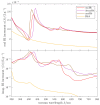Function of Hemoglobin-Based Oxygen Carriers: Determination of Methemoglobin Content by Spectral Extinction Measurements
- PMID: 33578723
- PMCID: PMC7916497
- DOI: 10.3390/ijms22041753
Function of Hemoglobin-Based Oxygen Carriers: Determination of Methemoglobin Content by Spectral Extinction Measurements
Abstract
Suspensions of hemoglobin microparticles (HbMPs) are promising tools as oxygen therapeutics. For the approval of clinical studies extensive characterization of these HbMPs with a size of about 750 nm is required regarding physical properties, function, pharmaco-kinetics and toxicology. The standard absorbance measurements in blood gas analyzers require dissolution of red blood cells which does not work for HbMP. Therefore, we have developed a robust and rapid optical method for the quality and functionality control of HbMPs. It allows simultaneous determination of the portion of the two states of hemoglobin oxygenated hemoglobin (oxyHb) and deoxygenated hemoglobin (deoxyHb) as well as the content of methemoglobin (metHb). Based on the measurement of collimated transmission spectra between 300 nm and 800 nm, the average extinction cross section of HbMPs is derived. A numerical method is applied to determine the composition of the HbMPs based on their wavelength-dependent refractive index (RI), which is a superposition of the three different states of Hb. Thus, light-scattering properties, including extinction cross sections can be simulated for different compositions and sizes. By comparison to measured spectra, the relative concentrations of oxyHb, deoxyHb, metHb are accessible. For validation of the optically determined composition of the HbMPs, we used X-ray fluorescence spectrometry for the ratio of Fe(II) (oxyHb/deoxyHb) and Fe(III) (metHb). High accuracy density measurements served to access heme-free proteins, size was determined by dynamic light scattering and analytical centrifugation and the shape of the HbMPs was visualized by electron and atomic force microscopy.
Keywords: HbMP; artificial blood substitute; hemoglobin-based oxygen carrier; light scattering; methemoglobin determination; spectral extinction; spectral refractive index; sub-micrometer particle characterization.
Conflict of interest statement
The authors declare no conflict of interest.
Figures





References
-
- Carson J.L., Grossman B.J., Kleinman S., Tinmouth A.T., Marques M.B., Fung M.K., Holcomb J.B., Illoh O., Kaplan L.J., Katz L.M., et al. Red blood cell transfusion: A Clinical practice guideline from the AABB. Ann. Intern. Med. 2012;157:49–58. doi: 10.7326/0003-4819-157-1-201206190-00429. - DOI - PubMed
MeSH terms
Substances
Grants and funding
LinkOut - more resources
Full Text Sources
Other Literature Sources

